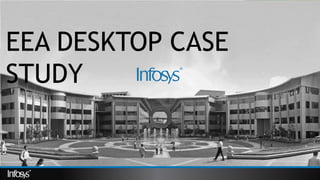
EEA DESKTOP CASE STUDY
- 2. The context… 2 1,30,000 employees • Total employees in Infosys at the end of 2010-11 28 million sq.ft. • Total built-up space of Infosys, India at the end of 2010-11 265 million units • Annual electricity consumption @ Infosys, India in 2010-11 1 million units • Consumption per working day @ Infosys, India in 2010-11
- 3. Our Carbon Footprint 3 Mobility 34% Electricity 66% Air conditioning 40% Lighting /Raw power 15% UPS 40% Misc. 5% Employee commute 24% Business travel 76% Electricity Mobility
- 4. Green Team Lighting AC Water Biodiversity Landscape Metering Renewable energy Awareness • Tomake Infosys a global leader in environmental sustainability • Tobe the trendsetter in the industry • Work with best resources available globally • Todemonstrate the feasibility of cutting edge technologies to impact the society at large 4
- 5. Integrated DesignApproach 5 Question all assumptions
- 6. Promote interaction between design consultants 6 • Building envelope performance as part of the architect’s contract − Maximum envelope load parameter • Day lighting criteria as part of architect’s contract − Day lighting to be achieved as per LEED standards • Performance criteria for HVAC consultant − Criteria on overall energy efficiency of the system
- 7. Window Strategies: maximize day light 7 Light shelves allow daylight to penetrate deeper into thebuildings Bright day light without glare at SDB-5 Mysore Mysore SDB 5 building with above strategies
- 8. 8
- 9. 3X reduction in lighting energy 9 2X reduction in the installed lighting load ~3X reduction in lighting energy consumption
- 10. Case Study: SDB-5 Mysore (40% reduction) 10 Sl. No. Case Chiller capacity required (TR) Annual energy consumption (kWh) Maximum electrical load (kW) 1 Conventional building envelope 622 3,244,284 1,052 2 Efficient building envelope 530 3030908 968 3 Efficient lighting design 510 2713390 882 4 Efficient computers 486 2358776 778 5 Variable Air Volume system for AC 486 2080462 754 6 Heat Recovery Wheels for AC 400 2015430 662 7 Ultra high efficiency chiller 400 1992156 650 8 Efficient chilled water system design 400 1960898 640 9 High efficiency cooling tower 400 1946532 632 10 Lighting controls 400 1,775,706 600
- 11. Cooling/Heating Strategy from old monuments 11 Thermal mass cooled by flowing Yamuna water Thermal energy stored in thick walls and floors
- 12. Fundamentals of Physics and Heat transfer 12 Convection Conduction Radiation Solid Liquid Gas Least Efficient Most Efficient Specific heat of water 4.2 kJ/kg deg K Density of water 1000 kg/m3 Specific heat of air 1.0 kJ/kg deg K Density of air 1.25 kg/m3
- 13. Innovative cooling technology – Radiant Cooling 13
- 14. • Air system is about 1/5th of a conventional air conditioned building – lesser ducting and lower fan power • Water is the main medium of heat transfer – pumping energy much smaller compared to fan energy. • Chilled water temperature in the radiant pipes is 15 to 18 0C – chillers run at high efficiency • Perception of thermal comfort is higher compared to a conventional air conditioned building Radiant Cooling – Advantages 14
- 15. Radiant Cooling – Hyderabad Building 15
- 16. 3X reduction in air-conditioning energy 16 • Figures based on actual measured data in Hyderabad buildings for Mar – Jul 2011 • 3X improvement in efficiency compared to 2007 design • Radiant cooling at no additional cost
- 17. Radiant Cooling – Third Party Evaluation 17
- 18. Radiant Cooling – Third Party Evaluation 18
- 19. Radiant Cooling – Actual Data 19
- 20. Radiant Cooling – Actual Data 20 kWh
- 21. >200% improvement in overall energy efficiency of new bldgs 21 Existing buildings of Infosys New Design Cutting edge design
- 22. • Building envelope heat load not to exceed 1.0 W/sqft •More than 75% of the office area to be naturally lit as per LEED standards Breaking the barrier………….. • > 550 sqft per TR of AC area • < 0.4 W/sqft for lighting design • < 0.5 kW/TR for chiller plant design • < 3.5 W/sqft for electrical design Redefining the standards 22
- 23. Experiences / Conclusions 23 • Set unreasonable targets • Efficient buildings do not cost more, but need a little effort • Good design = job half done ! • Question all assumptions and get the sizing right • Select right sized efficient equipments and smart controls • Measure, monitor……..Measure, monitor………..feedback…. • Seeing is believing……………Welcome to Infosys.